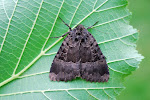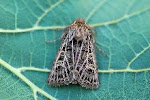In terms of the wildlife, of course the main interest was the birds. They were indeed amazing, and see here for a trip report: http://www.birdforum.net/showthread.php?t=244125 I didn't spend too much time looking for lepidoptera, and remember that the time of year was thier equivalent of late April/early May, so there were not a great number of species on the wing. I ended up identifying two moths, and three butterflies.
The aptly named New Zealand Red Admiral was very common, but the Common Tussock (which I didn't get a photo of) was only seen at one site. The Boulder Copper is apparently NZ's commonest butterfly, but it's also thier smallest so its easily overlooked (about the size of Small Blue). The Helastia cinerearia was a day-flying moth, but the ID is rather tentative, as the number of similar Geometrids is more overwhelming than here! The Wiseana umbraculata was an easier ID, as its clearly one of the Swifts. It came to a lighted window at night.
New Zealand Red Admiral
Boulder Copper (female)
Boulder Copper (male)
Wiseana umbraculata
Helastia cinerearia
As an aside (and on an insect theme at least) I made this interesting discovery. I found this on a wall in a garden. Its the empty egg-case of a New Zealand Praying Mantis (NZ has two species). Unfortunately, I never saw any of the real thing.

























